
The founder and CEO of SALT Chamber, Leo Tonkin is a man of kindness and integrity who has literally aligned himself with the salt of the earth.
What year did you go into salt?
I founded SALT Chamber in 2012, a little more than 10 years ago, after learning about it in 2011, when I met somebody from Eastern Europe. I didn’t know that there was this device called a halogenerator, so I started to do my own research on salt therapy and soon discovered that nobody was doing this back then. My main career has been in leadership development, culture, and organizational behavior.
When did you tiptoe into the spa end of things? How did you put salt and spa together?
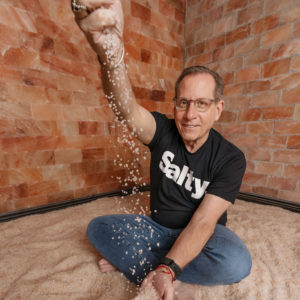
Leo Tonkin
When looking at the audience in Europe, in many places salt therapy is considered a medical treatment. For spa and wellness, I wanted to create salt therapy to be more of an experience in a cool room. Spas had relaxation rooms, an often-underutilized space. I went to ISPA and Global Beauty Exchange in 2013, educating and bringing awareness and then creating concepts.
What was the reaction of the spa industry at large, when you started talking about this back then? Was it, ‘Oh, this is interesting and new,’ or was it over people’s heads? Who were some of the first spas to get on board with you?
I remember working with Angie Smithee at the Hyatt Regency Gainey Ranch. We redesigned an unused room for salt therapy, and it quickly paid for itself. She has been a great testimonial. Then we did a salt room for Woodfield Country Club, then Caesars, then The LINQ Hotel.
“We don’t think about our breath until we can’t breathe.”
As you know, Mary, spa directors have influence, but they don’t make the decisions a lot of the times. So, I was trying to just get a little bit of education and awareness about the modality, about why it is beneficial and a great wellness treatment. Wellness, at that time, was just up and coming, and when you talk about respiratory wellness and the impact on skin, they started to see the connection between spa and wellness. I think it took about three years or so, by 2015 it really took hold.
Making an underutilized room profitable is especially important post-Covid. To fast forward, with labor shortage, what a great way to generate revenue with underutilized space and no labor costs. Spa is moving more into self-care, as well. I started to realize that this was going to be a whole industry. In 2014, I was one of the founders of the Salt Therapy Association [STA], the trade association for the industry.
We started to go beyond spa and wellness. The very first senior living facility we did was outside of Portland, Oregon.
Talk a little bit about the association. How many members? Is it global? And what are you trying to accomplish?
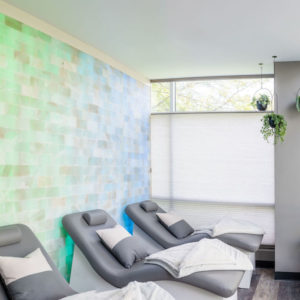
The salt room at Well-Infused, Noblesville, Indiana
It’s a non-profit association with 3,500 members in 33 countries. I went around the world and found the most influential people in the industry—like a woman physician based in Budapest who co-founded one of the halogenerator companies and published research articles on salt therapy—and a pulmonologist out of Orlando who worked with a lot of children with cystic fibrosis. STA focuses on education, research, and innovation, and hosts an annual conference for the industry, as well as consumers at large.
Our conference attendees offer other wellness modalities like cryotherapy and flotation. Salt goes with everything; you see it in chiropractor offices, you’re seeing it in veterinary practices. It’s used in In horse racing and fitness clubs for performance and recovery. I recently attended Dave Asprey’s biohacking conference in Beverly Hills, and I was surprised how many people had not heard about salt. That was the barrier with the spa industry. A lot of people don’t know what salt therapy is. Even more importantly, you have people in the industry misrepresenting salt therapy.
I’m going to jump around a little bit. You mentioned all of these different verticals—animals, humans, fitness. Is there a certain size of salt chamber that one must begin with to be a healing room?
The airspace is saturated with salt particles. There’s a certain amount of micro-particles within a space. The smaller the room, the less time to fill up the room with the appropriate amount of salt particles. If you look at a typical treatment room, that might be a 10-feet x 12-feet room, for example. You know, you’re looking at about a 25-minute session, and then when you’re looking at a very small space, like our salt booth, which is a stand-alone individual unit, about 10 minutes. So, the room makes a difference. The size depends on the facility’s needs. At the Biltmore Waldorf Astoria in Phoenix, we are literally building a salt room as a freestanding building. I think it is going to be 12 feet x 16 feet.
I’ve seen a lot of different salt rooms, and a lot of them look very different from one another. Must a true salt room or salt chamber be entirely coated or covered with the salt to work properly and really give the benefits? I was just on a brand-new luxury cruise ship and they had what they called a salt room that featured one small panel of salt. When I entered the space, I immediately thought (and felt), ‘this just isn’t a salt room.’
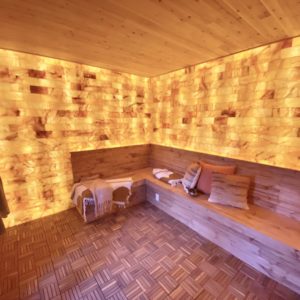
The elaborate salt room at Arizona Biltmore, Phoenix, Arizona
Initially, when I got involved in this 10, 11 years ago, salt rooms were being designed based on underground European salt caves. The very first salt rooms designed above ground had white salt walls to mimic a cave-like environment. I didn’t think that was a very inviting environment for Americans unfamiliar with salt caves, so I started using Himalayan salt as a décor element. I was the pioneer of how to backlight and create salt block systems to create ambiance. There is a fallacy that Himalayan salt gives off negative ions and it cleans the air around it. A class-action lawsuit in New York had scientists disprove these claims, but there are still companies in the spa industry selling Himalayan salt making false claims.
Some of our projects are strictly décor, and we have to explain that to our clients. Hard Rock Casino wanted a salt room, and we said what about the piece of equipment that distributes the dry salt particles? They didn’t know what we were referencing. Well, if you want to have a salt room, you need to enclose the room. We need to modify the HVAC system, et cetera. Well they said, ‘No, we’re just going to make it a meditation room.’ So we developed a beautiful room for them.
We’ve done salt décor in restaurants, and even in private homes. Utilizing salt as décor or architectural elements is in our wheelhouse–but making claims that you get health benefits from this is absolutely BS. Quite frankly, there are people in the industry selling things a certain way. I don’t want to put people under the bus, but I also want to maintain the integrity of the modality. That’s why I get a little passionate about it.
What’s your biggest challenge right now within the spa and wellness community?
Education and awareness. There’s still confusion, and people need to know more about the benefits. To your earlier point, people don’t need to have a large space. At the remodeled PGA National, we designed these really cool small, booth-like salt rooms that can accommodate two people. Developers and operators can create more value in their amenity, it keeps them up with the Joneses, so to speak—but it also really provides great results for guests and residents.
In layperson terms, what is so great about salt therapy? What does it really do?
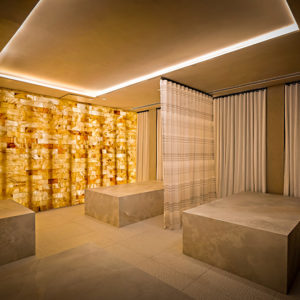
Solaia Condominiums, North Bergen, New Jersey
Well, think of it this way, you and I take about 20,000 breaths a day. If I were to pour you a glass of water and it was dirty, you probably wouldn’t drink it. Well, the question becomes what’s in the air that we breathe? When you think about the real issues, that’s how diseases get transmitted. So, you need to start looking at why do people have allergies and asthma, COPD, and lung cancer? The respiratory system is the number one thing that impacts us as human beings. And it’s also what determines our longevity and quality of life. We don’t think about our breath until we can’t breathe.
Salt therapy is a way of cleansing and proactively maintaining the respiratory system. You must have a machine that grinds dry salt into such small particles that they are suspended in the air, and you’re breathing them in. Your lungs are like a sponge, so when you breathe it in, they absorb the mucus along with pathogens and allergens that get stuck in our system. It pulls it out, it also kills it. Salt is antibacterial and anti-inflammatory. For people who have asthma, for example, when they breathe this in, it opens the airways. It acts like a natural inhaler, so they’re consuming more oxygen. For athletes, it creates more oxygen to red blood cells. For horses, it’s doing the same.
Ninety percent of the planet, according to the World Health Organization, is breathing poor indoor air quality; there is pollution in our HVAC system. Salt therapy is a good solution to the problem. It is something that’s natural, and it works. There’s evidence that it’s safe for young people to seniors. You can create an experience around it. It is starting to get a lot more noticed, and that’s why I’m focusing not only on salt therapy, but respiratory health, and that’s why I started the Global Wellness Respiratory Initiative.
What should I tell my readers who want to experience a salt room? When you go into a place, how do you know you’re going to get the real deal?
First and foremost, find out if they have a halogenerator. Is there a device that is crushing and grinding the salt and dispersing it into the room, and is it dry salt? The salt needs to be a pure-grade sodium chloride. You can’t put in Morton table salt. You can’t put in Himalayan salt. The Salt Therapy Association has standards.
If this continues to trend, will there ever be a salt shortage?
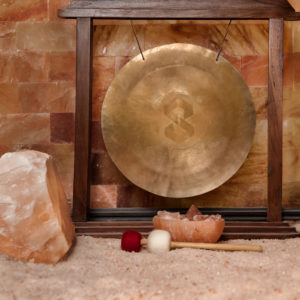 Himalayan salt is a natural element that has been around for 200 million years. I do believe there is a limited supply. Manufacturing sodium chloride is a natural process extracted from salt flats from evaporation in certain lakes. It is part of the ecosystem. I don’t think we’re going to have any issue about it, but if you’re asking me about Himalayan salt that is mined, it may be an issue.
Himalayan salt is a natural element that has been around for 200 million years. I do believe there is a limited supply. Manufacturing sodium chloride is a natural process extracted from salt flats from evaporation in certain lakes. It is part of the ecosystem. I don’t think we’re going to have any issue about it, but if you’re asking me about Himalayan salt that is mined, it may be an issue.
Sustainability is important to SALT Chamber. We make our salt booths here in the United States. Our equipment is made in the medical device facility that makes nebulizers and blood pressure equipment. SALT Chamber has always been about the integrity and the quality of what we do. We are involved with an organization called OneTreePlanted.org. For every SALT room that we sell, we plant 20 trees.
One of the reasons we want to take care of the environment is because climate change makes a difference to the quality of our air. You have longer allergy seasons now, and Covid brought more awareness to respiratory conditions. Our goal is to make salt therapy more of an experience. We’re working with people who do breathwork or crystal bowl and Tibetan Bowl healing music inside of a salt room, as well as people who work with salted yoga or salted massage.
Can’t we just enjoy the salt room itself without bringing in all the bells and whistles?
There is something about taking a time-out, and there’s something about a good breath and what that does overall—and I agree that you don’t need the bells and whistles. There are some companies out there that are mixing red-light sauna and even putting a bicycle in the salt room, and I disagree with that. I think a sauna is a sauna experience. You don’t need to complicate it with other things.
Mary Bemis
Mary Bemis is Founder & Editorial Director of InsidersGuidetoSpas.com. An advocate for all things spa, Mary forged a vocabulary for spa reportage that is widely used by those who cover the issues today. Recently honored as a Top 30 Influential Voice Transforming Wellness by Medika Life, Mary is an inaugural honoree of Folio’s Top Women in Media Award. Her spa media roots run deep—in 1997, she launched American Spa magazine, in 2007, she co-founded Organic Spa magazine, and in between serving on the ISPA and NYSPA Board of Directors, she was on the launch teams of Luxury SpaFinder and New Beauty magazines. Named a "Wonder Woman of Wellness" by American Spa magazine, Mary was honored by the International Spa Association with the distinguished ISPA Dedicated Contributor Award. She is a special advisor to the non-profit Global Wellness Day.
- Web |
- More Posts(81)